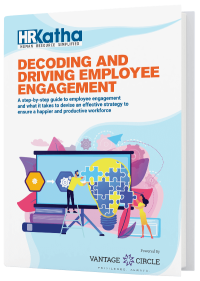Let's Burst the Bubble of Employee Engagement Myths

Employee engagement is an indispensable part of the growth of any organization. It is a broad, abstract, and ever-evolving process, and because of its nature, it is a common ground for myths and misunderstandings. By bursting each employee engagement myth, you will get a more transparent and more precise idea for building an engaged workforce!
Employee Engagement Myth 1: Sincere employees = Engaged employees
We often consider engaged employees are synonymous with sincere employees. Employees who are regular, punctual, and hardworking are not necessarily involved. They can be just as disengaged at their job as any other employee. While discipline and sincerity are indicators of top performers, these are not definite traits of highly engaged employees.
The very premise of an engaged workforce is for one to go beyond expectations. An engaged employee seeks better, effective, and efficient ways to contribute to the organization.
Employee Engagement Myth 2: Employee engagement requires a huge budget
It is a common perception that Employee engagement is a costly endeavor. But it isn’t.
The building blocks of employee engagement such as employee recognition, robust internal communication, transparent and fair culture, effective leadership begin with company practices. All these factors can be worked upon by the sincere efforts of the people at various levels of the organization.
Although you can do many things in the engagement space, many of the HR tools are available free of cost. All you need to do is give a jumpstart to your journey!
(Read: Corporate Employee Benefits at ZERO cost)
Employee Engagement Myth 3: Employee engagement is solely HR’s responsibility
Another major myth is that Employee engagement is a managers’ duty. The responsibility doesn’t rest on the shoulders of the top-level, either. On the contrary, it is a collective responsibility. Employee engagement is active participation and genuine effort of all the organization's people.
While HR or the managers play a special role in the equation, it is the collective effort to bear the fruit. Managers can play a more significant role by including everyone in the process. They should conduct surveys and organize meetings to encourage suggestions and implement the best ideas.
Employee Engagement Myth 4: Happy employees = Engaged employees
People often think that engaged employees are happy employees and vice versa.
The truth, however, is that many factors govern happiness, and you cannot take it as an indicator for engaged employees. Moreover, happiness need not correlate with the effectiveness and efficiency of your employees.
Build a happy workplace, by all means. It is vital. Then again, don’t rest your hopes of an efficient and engaged workforce on a happy one alone.
Employee Engagement Myth 6: Employee engagement is just another trend
Many consider employee engagement as an in-thing or a trend that will go off-radar in the coming years. But statistics, surveys, and case studies prove that employee engagement is as accurate and as effective as it gets.
Employee engagement is an inseparable aspect of the growth of an organization. With changing dynamics of the work environment, the need for building an engaged workforce has increased by many folds. Millennials and Gen Z employees seek effective employee engagement practices over paychecks.
If there is one thing I can guarantee, employee engagement isn’t going anywhere any time soon.
(Read: Employee Engagement Trends)
Employee Engagement Myth 7: Employee engagement is all about perks and benefits
Having attractive employee perks and benefits is an excellent proposition for any company. It presents a caring image of the company and makes the job profile attractive. Perks and benefits increase motivation among employees. But you cannot perk your way to employee engagement.
Engagement is the state of being emotionally invested in the company. It can come to reality when all the factors collectively come into play. Offering meaningful and well-thought-out benefits is the responsibility of an employer. But it shouldn’t be the entirety of your engagement efforts.
Employee Engagement Myth 9: One-size-fits-all solution
There is no one-size-fits-all solution to employee engagement. People often assume that drivers of employee engagement are the same across organizations. No two organizations are the same. Similarly, motivators of employee engagement also cannot be the same across organizations.
There are indeed some essential components of employee engagement. However, Policies and practices for two companies will not necessarily bear the same results.
Every organization should, therefore, run its internal employee surveys and brainstorm strategies. Factors like location, demographics, diversity, etc., play an essential role.
Employee Engagement Myth 8: Engagement = Retention
Reducing employee turnover is a prime concern for every organization. Employee engagement can be a significant player in a reasonable retention rate. However, you cannot take it as a sure-shot way to increase employee retention. Engagement is not simply a problem that you need to solve.
There can be many attributes to your employees leaving. While sound engagement strategies will help you tackle some hurdles, others will be beyond your control.
Creating an employee-friendly work environment and offering an overall good employee experience should be the ultimate aim of your employee engagement efforts.
Employee Engagement Myth 9: Employee Recognition Not Correlated with Employee Engagement
All human beings have an intrinsic need to be appreciated and applauded. Today, job opportunities are plentiful, and job-hopping is a common phenomenon among millennials. Therefore, the need for employee recognition is even huge. Employee recognition has a direct correlation with motivation at work. Which directly affects the quality and efficiency of work.
Recognize and affirm people when they contribute to the mission you share. Do this, and you will ignite their purpose and potential.
– Mike Byam
Recognition is the most ignored and taken-for-granted aspect of employee engagement. Organizations are yet to acknowledge the role it plays and implement it effectively. It is the core of your employee engagement efforts, which will help your organization be a hundred ways.

Vantage Circle is a simple AI-powered Rewards & Recognition Platform for upgrading your employee experience and engagement for better productivity.






